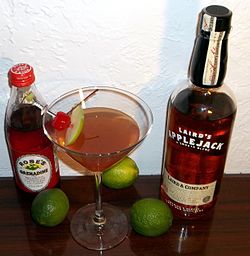| Revision as of 21:02, 23 January 2013 editFakirNL (talk | contribs)Extended confirmed users7,395 edits / it looks like eachother, wonder whether it tastes the same as well... :-)← Previous edit | Revision as of 06:26, 28 January 2013 edit undoDavid Hedlund (talk | contribs)Extended confirmed users13,269 edits →ProductionNext edit → | ||
| Line 13: | Line 13: | ||
| Rather than consume an alcoholic fruit beer, the cider harvested in the fall was often separated in the winter via freeze distillation, by leaving it outside and periodically removing the frozen chunks of ice, thus concentrating the unfrozen alcohol in the remaining liquid. From the fermented juice, with an alcohol content of less than 10%, the concentrated result contains 30-40% alcohol. | Rather than consume an alcoholic fruit beer, the cider harvested in the fall was often separated in the winter via freeze distillation, by leaving it outside and periodically removing the frozen chunks of ice, thus concentrating the unfrozen alcohol in the remaining liquid. From the fermented juice, with an alcohol content of less than 10%, the concentrated result contains 30-40% alcohol. | ||
| It is slightly sweet and usually tastes and smells of apples. | |||
| It is slightly sweet and usually tastes and smells of apples. However, freeze distilling concentrates all of the alcohol by-products of fermentation – including the less desirable ] and ]s as well as ]. Distillation by evaporation can separate these since they have different boiling points. | |||
| ] can concentrate ] and fusel alcohols (by-products of fermentation which true distillation separates out) in ] to unhealthy levels. As a result, many countries prohibit such applejack as a health measure.<ref>http://encycl.opentopia.com/term/Applejack</ref> However, reducing methanol with the absorption of 4A ] is a practical method for production.<ref>http://124.205.222.100/Jwk_spkx/EN/abstract/abstract15544.shtml</ref> Also, distillation by evaporation can separate these since they have different boiling points. | |||
| With easy availability of grain, metal ]s, clean water, and eventually ] starting in the mid-19th century, cider and applejack were gradually displaced by other beverages and ]. In the late 19th and early 20th centuries, traditional applejack acquired a stigma as a result of its association with the older production process, and was less economical to produce than some alternatives. | With easy availability of grain, metal ]s, clean water, and eventually ] starting in the mid-19th century, cider and applejack were gradually displaced by other beverages and ]. In the late 19th and early 20th centuries, traditional applejack acquired a stigma as a result of its association with the older production process, and was less economical to produce than some alternatives. | ||
Revision as of 06:26, 28 January 2013
| This article needs additional citations for verification. Please help improve this article by adding citations to reliable sources. Unsourced material may be challenged and removed. Find sources: "Applejack" drink – news · newspapers · books · scholar · JSTOR (January 2010) (Learn how and when to remove this message) |

Applejack is a strong alcoholic beverage produced from apples, popular in the American colonial period.
History
Applejack was historically made by concentrating cider, either by the traditional method of freeze distillation or by true evaporative distillation. The term applejack derives from jacking, a term for freeze distillation. The modern product sold as applejack is no longer produced using this traditional process.
In New Jersey, applejack was used as currency to pay road construction crews during the colonial period. A slang expression for the beverage was Jersey Lightning.
Production
Freeze distillation is a low-infrastructure method of production compared to evaporation distillation. Apples and applejack have historically been easy to produce in small quantities. Hard apple cider was an important drink in the colonial and early years of the United States, particularly in areas without access to clean water, but was often considered insufficiently palatable and bulky to store.
Rather than consume an alcoholic fruit beer, the cider harvested in the fall was often separated in the winter via freeze distillation, by leaving it outside and periodically removing the frozen chunks of ice, thus concentrating the unfrozen alcohol in the remaining liquid. From the fermented juice, with an alcohol content of less than 10%, the concentrated result contains 30-40% alcohol.
It is slightly sweet and usually tastes and smells of apples.
Freeze distillation can concentrate methanol and fusel alcohols (by-products of fermentation which true distillation separates out) in applejack to unhealthy levels. As a result, many countries prohibit such applejack as a health measure. However, reducing methanol with the absorption of 4A molecular sieve is a practical method for production. Also, distillation by evaporation can separate these since they have different boiling points.
With easy availability of grain, metal stills, clean water, and eventually pasteurization starting in the mid-19th century, cider and applejack were gradually displaced by other beverages and liquors. In the late 19th and early 20th centuries, traditional applejack acquired a stigma as a result of its association with the older production process, and was less economical to produce than some alternatives.
See also
- Calvados (brandy), a similar French drink
References
- ^ Black, Rachel (2010). Alcohol in Popular Culture: An Encyclopedia. Santa Barbara, CA: AB-CLIO, LLC. p. 10. ISBN 978-0-313-38048-8. Retrieved 10/22/2011.
{{cite book}}: Check date values in:|accessdate=(help) - Karen Tina Harrison, Jersey Lightning, New Jersey Monthly, July 13, 2009.
- http://encycl.opentopia.com/term/Applejack
- http://124.205.222.100/Jwk_spkx/EN/abstract/abstract15544.shtml
| Alcoholic beverages | |||||||||||
|---|---|---|---|---|---|---|---|---|---|---|---|
| |||||||||||
| |||||||||||
| |||||||||||
| |||||||||||